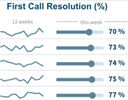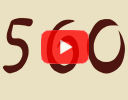IntMath Newsletter: Math art code, graphs, random numbers
By Murray Bourne, 17 Jan 2018
17 Jan 2018
In this Newsletter:
1. Math art in code
2. Resource: Making graphs easier to understand
3. Math in the news: Truly random numbers
4. Math movies
5. Math puzzle: Sum the digits
6. Final thought: Truth
1. New on IntMath
(a) Math art in code
This is a new section in IntMath. There are many beautiful images and animations created using computer code with a mathematical basis. Some of them are quite simple to produce and could make good class exercises (or mini-projects) at the intersection of mathematics, coding and art. (STEAM, in other words!)
 |
Delaunay Triangulation is a specific kind of triangulation (the important mathematical concept used in everything from engineering to computer graphics). See some math, art and coding at: |
(b) IntMath accessibility
During my university days I volunteered to help a group of blind people with their daily tasks. Ever since, I've been interested in the alternative ways blind people can learn - especially in the area of mathematics. For a long time I've wanted to make IntMath more accessible, but have never found the time until recently.
To make a Website "accessible", you need to add (and sometimes rearrange) the underlying code so that it makes more sense for screen readers. (For example, you may have seen a "Skip to main content" link at the top of some Web pages - that saves the blind person having to listen to all the links and image descriptions at the top of most page.)
 |
Anyway, I've recently begun to work on accessibility of IntMath. If you - or someone you know - uses a screen reader when browsing the Web, please give me feedback on how I can improve the accessibility of IntMath. (I know I still have a long way to go...) |
2. Resource: Making charts and graphs easier to understand
The ability to present data in meaningful ways becomes more of a marketable skill with every passing day.
Usability experts, Nielsen Norman wrote a great article on how to present graphs so that users experience the least "cognitive load" - and hence can figure out what it means quicker.
 |
Math students and teachers alike should find this useful. See: |
3. Math in the news: Truly random numbers
Almost all coding languages have a "random" function, which is meant to produce a random number. (There's an example in the Delaunay Triangulation page referred to before.)
However, it never is truly random, since it is often based on some "seed" value, and can be reproduced if the seed is known. Truly random numbers are really important for effective cybersecurity.
 |
This article describes a 2016 breakthrough where University of Texas researchers claim to have achieved it in a quite practical way. See: New method of producing random numbers could improve cybersecurity. |
4. Math Movies
I have a backlog of math videos to share, so I will include 2 in each Newsletter for a while.
(a) Can a robot pass a university entrance exam?
(b) A brief history of banned numbers
The Pythagoreans were very strict about the numbers you could - and could not - talk about. (There is a story about one of his followers being killed for proving the existence of irrational numbers.) To this day we have numbers that are thought of as "special" (like unlucky 13, or 666, or 4).
 |
Here's a look at some of the numbers that have been banned throughout history: |
5. Math puzzles
The puzzle in the last IntMath Newsletter asked about the shaded portion of a triangle.
Correct answers with explanation (covering a wide variety of approaches) were given by: Ihage, Francis, Rick, Aled, Danesh, Thomas, Chris, JDK, Tomas, Vijay, Eamon, and Gerard.
My incorrect addition: In the last Newsletter, I added an extra example involving degenerate conics. Unfortunately, I was "off on a tangent", and some of you (Chris, Alan, Eamon) questioned me on it. You were right and I corrected that part of the post. (Whenever we make a mistake, we should immediately admit to it and correct it. More on this in the "Final Thought" below.)
New math puzzle: Sum the digits
What is the sum of the digits of the number (1025 − 25)?
You can leave your responses here.
6. Final thought: Truth
It should concern any educated person in current times that the most effective way to convince people of a certain point of view is to say it often enough, and to brush aside criticisms — not by presenting solid evidence — but by sowing doubt. There many examples thoughout history of this working well, especially to allow big business to get away with scandalous things (e.g. the tabacco industry, leaded fuel, nuclear power in Japan).
Late in 2017 there were reports that officials at the (US) Centers for Disease Control and Prevention had been asked to refrain from using the words "evidence-based" or "science-based" in their funding submissions. This kind of thing has never ended well in the past, and won't this time. Beware those who think the "post-truth" era is acceptable, or even a good thing.
Words matter and truth matters.
Bertrand Russell had this to say about mathematics, a field of science (like all of them) that relies on proof and evidence.
“Mathematics, rightly viewed, possesses not only truth, but supreme beauty—a beauty cold and austere, like that of sculpture, without appeal to any part of our weaker nature, without the gorgeous trappings of painting or music, yet sublimely pure, and capable of a stern perfection such as only the greatest art can show.” [Bertrand Russell]
[Hat-tip to PiPo for alerting me to some of the items in this Newsletter.]
Until next time, enjoy whatever you learn.
See the 10 Comments below.

19 Jan 2018 at 11:20 am [Comment permalink]
1025 is “1” followed by 25 zeros.
Subtracting 25 from it, will change the last two digits to “75” and the rest of the 23 zeros will become “9”, with the leading “1” disappearing.
So the sum of the digits is 23 x 9 + 7 + 5 = 219.
19 Jan 2018 at 1:32 pm [Comment permalink]
Answer is 219
20 Jan 2018 at 7:54 am [Comment permalink]
The answer is obtained readily using Mathematica:
10^25 - 25 = 9999999999999999999999975
Total[IntegerDigits[10^25 - 25]] = 219
20 Jan 2018 at 2:54 pm [Comment permalink]
As we can see from the following observation
100-25=75
1000-25=975
100000-25=99975
we see that 10^n - 25 has n-2 9s and 75
therefore 10^25-25 the answer has 23(25-2) 9s and 75
so the sum of the digits will be 23*9+7+5=219
21 Jan 2018 at 1:27 am [Comment permalink]
(10 ^ 25 - 25). Sum the digits in the answer.
(10 ^ 3 - 25) = 975. There is one 9 in the answer. The number of 9s is two less than the value of the index.
Thus the answer to the problem contains 23 9s and 75 which results in the sum of its digits being 219.
21 Jan 2018 at 8:03 pm [Comment permalink]
I'm sorry, Dave. I'm afraid I can't do that.
Something messed up. :-(